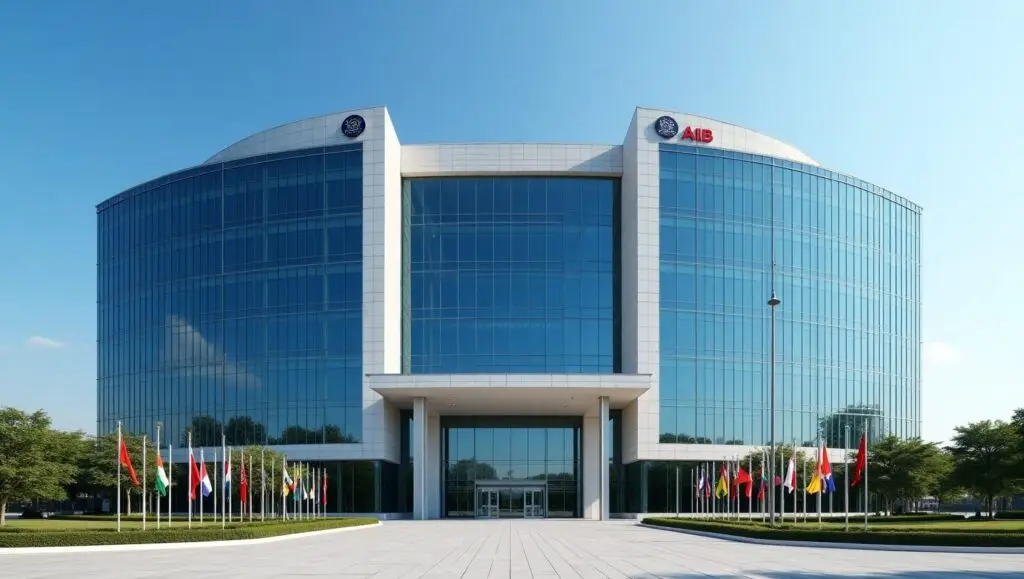What is the Asian Infrastructure Investment Bank?
Definition and Purpose of AIIB
The AIIB is a multilateral bank created to fund infrastructure projects in Asia. Its goal is to help countries build better roads, clean energy, and water systems. It aims for sustainable growth, which means development that lasts and doesn’t harm the environment. The bank was founded in 2016 by China, with many other nations joining later. Its strategic focus is to support projects that improve lives and strengthen economic ties across the continent.
Governance and Structure
The AIIB is run by its members, which include countries from Asia and beyond. Each member has a say in decision-making, based on how much money they contribute. The bank operates with a clear set of rules — more like a club that works together rather than a single boss. Compared to large banks like the World Bank, AIIB focuses on projects suited specifically for Asian countries’ needs. Members vote on projects, ensuring transparency and shared responsibility.
Funding and Capital Resources
AIIB gets most of its money from member contributions and bond sales. These funds are used to finance big projects that can give long-term benefits. The bank also follows strict rules to ensure it stays financially healthy, avoiding risky investments. Its investments follow clear policies, prioritising social and environmental safety. In turn, this keeps projects sustainable and impactful for local communities.
Formation and Objectives
AIIB was proposed by China in 2013 to address the glaring infrastructure deficits across Asia. With its headquarters in Beijing, the bank began with 57 founding members, expanding to over 100 approved members worldwide within a few years.
The bank’s core objectives are:
- To improve infrastructure connectivity within Asia
- To promote sustainable economic development
- To foster regional integration and cooperation
- To mobilise private capital for development projects
Capital Structure and Voting Rights
AIIB’s authorised capital stock is USD 100 billion, making it the second-largest multilateral development bank after the World Bank. Its capital is divided among members based on their economic size and GDP, with China as the largest shareholder holding approximately 26.5% voting rights, followed by India and Russia.
Voting power is structured into:
- Basic votes equally shared by all members
- Share votes based on each member’s capital subscription
- Founding member votes to provide additional voting strength to original members
Strategic Goals and Key Areas of Investment
Infrastructure Development Focus
AIIB targets key sectors like energy, transport, water, and digital networks. Asia needs huge amounts of infrastructure; estimates suggest trillions of dollars are needed over the next decade. These investments aim to modernise cities, reduce travel time, and bring clean power to more homes. Projects like roads, bridges, and smart cities are high on the list. They make everyday life easier while boosting economic growth.
Promoting Sustainable and Inclusive Growth
Green energy is central to AIIB’s plan. Projects that promote solar, wind, and hydro power are essential for fighting climate change. The bank wants to help countries adapt to new climate realities and reduce reliance on fossil fuels. It also encourages inclusive growth — making sure the benefits reach everyone, including vulnerable groups. Implementing social and environmental safeguards means projects won’t harm nature or communities.
Regional Connectivity and Economic Integration
AIIB promotes projects that connect countries and communities. Better roads, railways, and ports help trade move faster and cheaper across borders. Examples include the Asian Highway Network and projects linked to China’s Belt and Road Initiative. These investments strengthen ties, encourage tourism, and create jobs. The goal is to make Asia more linked, so everyone benefits from shared growth.
Key Projects Funded by AIIB
India’s Infrastructure Expansion
AIIB has provided substantial funding for India’s transport and energy sectors, including:
- Bangalore Metro Rail Project (USD 335 million)
- Andhra Pradesh Rural Roads Project (USD 455 million)
- Transmission System Strengthening in Tamil Nadu (USD 100 million)
Bangladesh Power System Upgrade
A USD 404 million loan for upgrading power transmission networks to reduce losses and improve grid stability.
Pakistan’s Hydropower Development
The Tarbela 5 Hydropower Extension Project co-financed with the World Bank, enhancing energy security and renewable power generation capacity.
Oman’s Duqm Port Development
Supporting the construction of commercial terminals and infrastructure to transform Duqm into a major logistics and industrial hub in the Middle East.
Indonesia’s Slum Upgrading Program
Funding of USD 216.5 million to improve urban living conditions and water sanitation facilities in Indonesian cities.
Global and Regional Influence of AIIB
Role in Shaping Asian and Global Economic Policy
AIIB influences how Asia funds projects, encouraging more responsible investments. Its focus on sustainability and regional development guides other institutions. It also works with international groups, sharing best practices and increasing effectiveness.
Strategic Partnerships and Collaborations
AIIB collaborates with countries like China, India, and Japan. It partners with ASEAN and other regional groups to promote infrastructure. Private companies and new finance tools—like green bonds—are also part of its strategy. These partnerships bring fresh ideas and funding sources.
Challenges and Criticisms
Some critics worry about political influence, especially since China is a major member. Environmental concerns also get raised over some projects. Transparency remains a challenge, but AIIB’s commitment to clear rules helps address these issues over time.
AIIB vs Other Multilateral Banks
Unlike traditional banks such as the World Bank and Asian Development Bank, AIIB focuses exclusively on infrastructure investment, maintains a non-resident board for efficiency, and adopts a project-based risk management model. Its fast-track approval process and lean operational framework attract both borrowing countries and private partners seeking agile financing solutions.
Environmental and Social Safeguards
AIIB integrates stringent environmental and social frameworks (ESF) into its project cycle to:
- Prevent environmental degradation
- Protect community rights
- Ensure equitable benefits distribution
- Uphold high standards of corporate governance
Future Outlook and Strategic Initiatives
Expansion Plans and New Investment Sectors
AIIB plans to grow beyond traditional sectors. Digital infrastructure, renewable energy, and urban resilience are future targets. The bank also wants more countries to join and expand its reach across Asia.
Innovation in Infrastructure Financing
Using green bonds, blended finance, and public-private partnerships, AIIB looks to make funding more effective. Emerging tech like smart infrastructure, IoT (Internet of Things), can make projects smarter and more efficient, making investments last longer.
Key Policy Recommendations for Stakeholders
Recipient countries should focus on clear planning and transparency to get the most out of investments. Private investors can find new opportunities, especially in green projects and smart cities. Collaboration and openness will be key to success.
Conclusion
AIIB is transforming Asia’s infrastructure landscape, helping countries grow in smarter, greener ways. Its projects support economic progress, regional ties, and sustainability. As it expands, AIIB can shape a future where growth benefits everyone, not just a few. Investing wisely today can build a better, more connected Asia tomorrow. If we continue to support responsible development, the possibilities for regional prosperity are endless.




